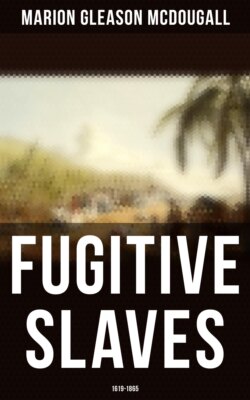Читать книгу Fugitive Slaves (1619-1865) - Marion Gleason McDougall - Страница 6
На сайте Литреса книга снята с продажи.
Dutch and Intercolonial Regulations.
Оглавление§ 6. Dutch regulations in New Netherlands.—The early New Netherlands regulations furnish many interesting provisions concerning fugitive servants. Apparently the servile class was numerous, and hard to govern. In the words of the ordinance of 1640, "many servants daily run away from their masters, whereby the latter are put to great inconvenience and expense; the corn and tobacco rot in the field, and the whole harvest is at a standstill, which tends to the serious injury of this country, to their masters' ruin, and to bring the magistracy into contempt." It was therefore ordained that runaways must, at the end of their term of indenture, serve double the time of their absence, and make good all loss and damage to their masters; while persons harboring fugitives were obliged to pay a fine of fifty guilders.21
§ 7. Escapes from New Amsterdam.—Within these Dutch colonies there is recorded a case of escape as early as 1659. Four menservants of Cornelis Herperts de Jager, of New Amsterdam, ran away to Manhattan. One of them soon returned, and in accordance with the regulation made in 1630 by the West India Company,22 requiring the return of fugitives in their various settlements, one of the officers of the colony sent to Manhattan an order to arrest and bring back the remaining three in chains.23
§ 8. Intercolonial regulations.—It will be seen that most of the colonies considered some provision against runaways necessary to the welfare of the settlements. To secure such legislation in a single colony was a comparatively easy matter; but the unorganized and sparsely settled condition of the country rendered any intercolonial regulations difficult.
The first formal agreement of this kind was arranged by the New England Confederation of Plymouth, Massachusetts, Connecticut, and New Haven, in 1643. In their Articles of Confederation was a clause which promised: "If any servant runn away from his master into any other of these confederated Jurisdiccons, That in such Case vpon the Certyficate of one Majistrate in the Jurisdiccon out of which the said servant fled, or upon other due proofe, the said servant shall be deliuered either to his Master or any other that pursues and brings such Certificate or 24 This clause contains the earliest statement of the principles regarding the treatment of fugitive slave cases, afterward carried out in the United States statutes of 1787, 1793, and 1850. There was no trial by jury, but the certificate of a magistrate was sufficient evidence to convict the runaway.
It is probable, also, that the rendition of fugitives was considered a duty incumbent upon all colonies, whatever their relation to each other, since about this time we find an agreement made for the mutual surrender of fugitives between the Dutch at New Netherlands and the English at New Haven.25
Not only did the slaves of the Dutch escape to the English colonies, but they often fled to the forests, where recovery must have been almost impossible unless the Indians could be induced to hunt them out. Curious rewards were sometimes offered. Maryland, in 1669, ordered that any Indian who shall apprehend a fugitive may have a "match coate," or its value.26 Virginia would give "20 armes length of Roanoke," or its value,27 while in Connecticut "two yards of cloth" was considered sufficient inducement.28
We have record of several conferences upon this subject. Governor Burnett of New York asked his Indians to exert themselves in behalf of the Governor of Virginia, who had written to him about the escape of several of his negro servants to the mountains. The Indians promised their help in this and any other search; but as they seldom seem to have succeeded, it is probable that their sympathy was with the fugitives.29 Again Governor Burnett demanded the restoration of a certain Indian slave whom they had kidnapped from the English. The Indians acknowledged the fact, but they said that he was then sold to others, and nothing further could be done.30
Canada even in these early times seems also to have been a haven for fugitives. In 1705 New York passed an act, which was renewed in 1715, to prevent slaves running away from frontier towns like Albany to Canada, because it was of great importance, they said, in time of war, "that no Intelligence be carried from the said city and county to the French in Canada."31
During all this time the Southern colonies, especially the Carolinas and Georgia, were also making many complaints in regard to the difficulty they had in recovering the fugitives, both Indian and negro, who were escaping in large numbers into Florida. There, among the Creek Indians and the Spanish at St. Augustine, they easily found refuge.32 This difficulty was, however, not remedied in colonial times, but continued long after the formation of the Federal Union, and in fact until the close of the Seminole war, in 1845.
